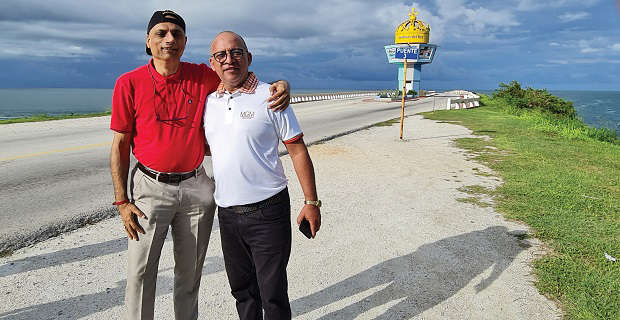CUBA A CHARMING LAND
One of my favorite places I’ve visited is Havana, Cuba. On my way home from Costa Rica, I spent a week in Havana. The colors, the music, the beautiful men and the cars! I love vintage and antique cars and own a couple myself. — Megalyn Echikunwoke

At the entrance to the scenic Jardines del Rey with Edilber, Sales Director at MGM Muthu Hotels,
who guided us through the journey
One of the striking and lasting images as we moved across Cuba in large Gaviota Tourism buses is the tranquil serenity of the countryside. The principal highways and autopistas in this Caribbean nation are lined with lush green tropical and semi-tropical vegetation; at numerous places there are dense, thick woods, testimony to a well-preserved natural and sustainable ecosystem in the region. Human settlements are few and far between along the highways. The distance between Cuba’s two largest cities—Havana with a population of 2.1 million, and Santiago de Cuba with another 1.04 million—is over 850 km. That mainly explains a rather low population density of 105 people per sq km in a nation with an overall land area of 109,884 sq km. With a population size of 11.11 million spread across 15 provinces, Cuba, part of the Greater Antilles, is the third largest inhabited island in the Caribbean after neighboring Haiti and Dominican Republic.
If there are kiosks or cafes on the highways, they are largely invisible; an occasional one may pop up in a village or small town enroute. There is a preponderance of seagrapes, pines, mangroves, banana trees, and grass banks on either side of these major arterial roads, they paint a green canvas soothing to the eyes. They dot the landscape enhancing the vista, as does, of course, the Cuban Royal Palm, the island’s national tree. This is the month of October, the rainy season is almost over, and the skies are almost always blue and clear. At many points during the comfortable bus drives we are pleasantly accosted by the majestic blue and green waters of the Atlantic Ocean stretching out into the horizon, as far as the eye can see—the timeless rising and falling of tides and the waves lapping the shores for millennia, a gentle reminder of the times when Christopher Columbus and his Spanish fleet must have sailed in and ‘discovered’ the islands in the year 1492.
King’s Gardens Archipelago
At times we were driven through highway tracts on reclaimed lands with the spectacular ocean waters on either side making for a unique experience. One such breathtaking view is provided at the entrance of the Jardines del Rey (King’s Garden) archipelago. According to leading websites like the cayocococuba.net, this is part of a larger archipelago known as Sabana-Camaguey that has over 2,500 small islands along the Atlantic coast and is connected with the principal land mass of Cuba through three causeways, known locally as the Pedraplen.
The Jardines del Rey archipelago itself stretches out for about 200 km on the south-eastern part of the Sabana-Camaguey and is dotted by several small islands or keys from the west to the east. They are popularly called Cayos, adapted from the Taíno word Cayo into the Spanish language. The major ones are the Cayo Guillermo and Cayo Coco islands, connected to one another through a short bridge. Thanks to the Muthu management and senior managers our stay and excursions to these places were made very comfortable.
The other islands are Cayo Paredon, Cayo Cruz, Cayo Las Brujas, Cayo Frances, Cayo Ensenachos, Cayo Santa Maria, Cayo Romano, Cayo Anton Chico, Cayo Megano Grande, Cayo Guajaba, Cayo Sabinal.











Comments.